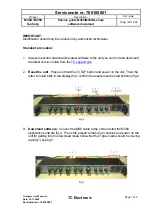
Unit Object Commands
www.3ware.com
73
:
disk=p:-p..
consists of a list of ports (disks) to be used in addition to the
source disks in the construction of the destination unit. One or more ports can
be specified. Multiple ports can be specified using a colon (:) or a dash (-) as
port index separators. A dash indicates a range and can be mixed with colons.
For example
disk=0:1:2-5:9:12
indicates port 0, 1, 2 through 5 (inclusive), 9
and 12.
group=3|4|5|6|7|8|9|10|11|12
indicates the number of disks per group for a
RAID 50 type. (This attribute can only be used when type=raid50.) Recall
that a RAID 50 is a multi-tier array. At the bottom-most layer, N number of
disks per group are used to form the RAID 5 layer. These RAID 5 arrays are
then integrated into a RAID 0. This attribute allows you to specify the number
of disks in the RAID 5 level. Valid values are 3 through 12. For example
group=3
indicates 3 disks of RAID 5 at the bottom layer of RAID 50.
Note that a sufficient number of disks are required for a given pattern or disk
group. For example, given 6 disks, specifying 3 will create two RAID 5
arrays. With 12 disks, specifying 3 will create four RAID 5 arrays under the
RAID 0 level. With only 6 disks a grouping of 6 is not allowed, as you would
basically be creating a RAID 5.
The default RAID 50 grouping varies, based on number of disks. For 6 and 9
disks, default grouping is 3. For 8 disks, the default grouping is 4. For 10
disks, the default grouping is 5, and for 12 disks, the disks can be grouped into
groups of 3, 4, or 6 drives (the group of 4 drives is set by default as it provides
Table 11: Valid Migration Paths
Destination
Source
R0
R1
R5 R6
R10
R50
Single
JBOD
Spare
R0
Yes
No
Yes
Yes
Yes
Yes
No
No
No
R1
Yes
No
Yes
Yes
Yes
Yes
Yes
No
No
R5
Yes
No
Yes
Yes
Yes
Yes
No
No
No
R6
Yes
No
Yes
Yes
Yes
Yes
No
No
No
R10
Yes
No
Yes
Yes
Yes
Yes
No
No
No
R50
Yes
No
Yes
Yes
Yes
Yes
No
No
No
Single
Yes
Yes
Yes
Yes
Yes
Yes
No
No
No
JBOD
No
No
No
No
No
No
No
No
No
Spare
No
No
No
No
No
No
No
No
No
















































